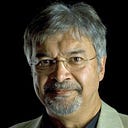Journey to the East (4)
What Bangalore, the “Silicon Valley of India,” was like fifty years ago — absolutely nothing like today!
In the previous story, Journey to the East (3), we had completed the arduous journey, by train, bus and car, to the South Indian “garden city” of Bangalore. There my mother and brother lived, in a beautiful villa, built in British times.
We repeated the journey a few more times, and spent weeks exploring the city and the surroundings. Later our son Martin, and then his younger brother Tommy joined us. There were adventures galore — today I will tell you a little about the earliest of our trips.
Bangalore was called the “Garden City of India.” It is located on the Deccan Plateau, around 1000 meters above sea level, and has a mild temperature — which is why my German father, who had worked for decades in the sweltering hot Bombay, moved to Bangalore after retirement. I spent a couple of years in my early teens in this house.
Today Bangalore, which has a population of around eight million, is called the “Silicon Valley of India”, because of its vibrant information industry. When we were there in the 1970s the town had just started to grow.
There is a story to tell about the above elephant. Note that it is being ridden by a “mahout,” the trainer and caregiver, and it is guided by an assistant on the street. I saw some youths on motor scooters ride up to the elephant and pluck hairs out of its tail — in order to braid them into “friendship bands.”
The next morning we read a calamitous report in the local newspaper: apparently, minutes after we had passed, the elephant threw a tantrum over the plucking of its tail hairs. For this it apparently held the assistant directly responsible. It grabbed him, dashed him to the ground and trampled him to death. In the meantime the mahout had dismounted and fled into a small roadside police cabin. The elephant followed and reached inside, trying to grab the mahout. Luckily the room was just large enough for the mahout to remain out of reach, and his life was spared. After half an hour police experts arrived with tranquillizer guns and were able to sedate the elephant. It had to be removed with a crane and a construction truck.
It was an experiment. I had a container made, of welded sheet metal, painted it black and connected it to the water mains. The theory: free hot water. However, the water pressure from the mains, though very weak, almost caused the container to burst. I need to work out the physics for this — how a small pump, working continuously, can build up tremendous forces.
Well, we Europeans notice that in this south Indian city people have very short shadows, especially around noon, like our sons on the right. This is because Bangalore is just 13 degrees north of the equator, and in the summer, when the sun climbs up to its zenith it is almost exactly 90° overhead. That is what Ingrid is testing, with a pendulum at noon.
One day, walking past a big hall, I saw that people were playing snooker, a game that has always fascinated me. A fifteen-year-old boy was thrilling the public with some beautiful shots. After he had won his match and been congratulated by the organisers, I chatted with him over tea and biscuits. The affable English lad told me all about his snooker career, and about his ambition to one day become the best snooker player in the world. I gave him a pat and some encouraging words — it is so nice to see how young kids are sometimes brimming with confidence. When I read in the papers a few days later that he had won the event outright, I was inclined to take him more seriously. So I memorized his name: Ronnie O’Sullivan. I kid you not.
